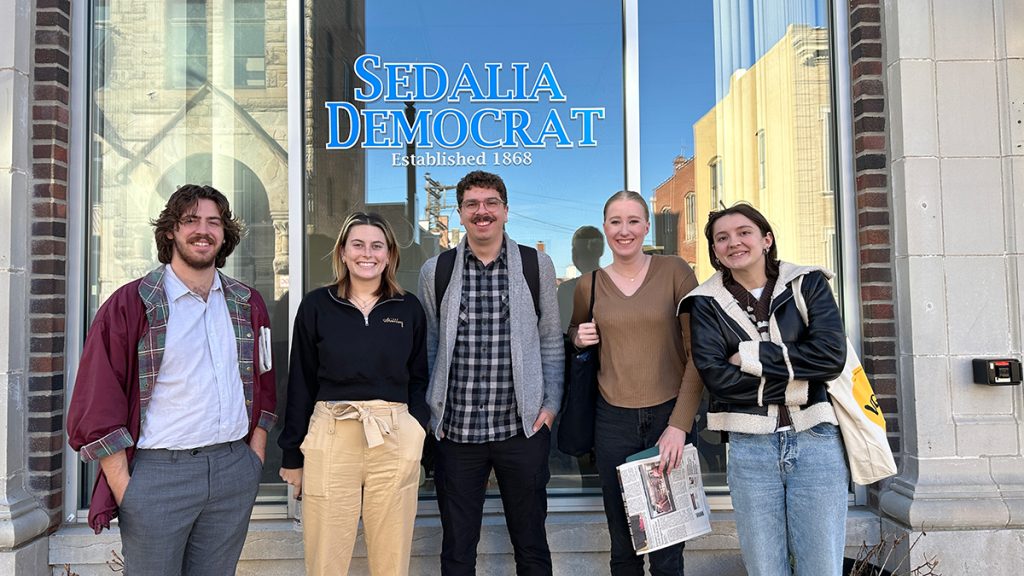
Students from the community news class during a field trip to the Sedalia Democrat. L-R: Quinn Coffman, Molly Miller, Eli Hoff, Emily Hood and Sam Barrett
Notes from the field: The power of location
The views expressed in this column are those of the author and do not necessarily reflect the views of the Reynolds Journalism Institute or the University of Missouri.
Elizabeth Stephens is the executive editor of the Columbia Missourian, the Missouri School of Journalism’s community newspaper, and the Missouri Community Newspaper Management Chair.
Last fall, I taught a course that looked at the state of community news and what the future looks like. We had guest speakers from startups, nonprofits and legacy newspapers talk about the successes and challenges of working in community news.
One of the most enlightening parts of the course was visiting community newsrooms around the state. We visited in person with eight news outlets, four on the west side of the state and four on the east side.
Based on these visits and the guest speakers, there were some overall takeaways and reminders about what is working and what is not for community newsrooms here in Missouri.
Local control makes a difference
The visits included a mix of locally owned news outlets and corporate owned newsrooms. When the control and ownership was handled locally, there appeared to be more success in both building revenue and providing quality journalism. It was clear in all the newsrooms that there was passion for serving their communities, but when employees felt supported with local leadership and not overstretched by corporate mandates, they seemed to be more engaged in the work.
Place matters
Throughout the course, we have read and discussed Nikki Usher’s book, “News for the Rich, White and Blue.” One of the premises of her book is that a local newspaper helps define a place. We could see that play out in our visits and conversations with journalists.
At Leader Publications, based in suburban St. Louis, they have added a new regional newspaper as recently as 2017. When considering whether to expand to cover a community, publisher Peggy Scott says they look to see if it is a place with its own identity — does it have a downtown, are citizens engaged in public life, etc. The way they are able to be successful in an area depends on the support of the community, and the community needs to have some pride in the place they live to support the newspaper.
We also saw a difference in where newspaper offices were located in a community. On one Zoom call, Echo Menges, editor of the Edina Sentinel, was interrupted because the sheriff came in to talk about a story she had reached out to him about. I asked her about it after overhearing the interaction, and she said the offices are across from the courthouse and major government buildings so the officials end up stopping by to talk about stories. “They figured out it was easier to come tell me what’s going on before I have to go hunting them down.”
The Sedalia Democrat has always had a downtown presence but did move about half a mile in the last year. The new location puts them even closer to the courthouse and government buildings for the city. During our hour-long visit, one reporter stepped out to cover a meeting and was back before we left.
We also saw readers and community members stopping by newspaper offices that were centrally located. The Northeast News, in suburban Kansas City located on Independence Avenue in the heart of the neighborhoods they cover, has a space for pop-up businesses in its front lobby, and one reader came in during our visit to get help finding a story she was looking for.
Local advertising is a revenue stream that needs more attention
The news outlets we visited were split on requiring a subscription and providing printed papers for free. The Webster-Kirkwood Times, which was purchased by employees in 2020, has free distribution by carrier every week. For the months in 2020 when the newspaper was not printed and delivered, readers continually asked when they would get it back. The owners figured out how to bring print back, but they were direct with readers that the way it works is local businesses buy the ads and the community needs to support those businesses. This cycle keeps businesses advertising and community members with a local printed newspaper.
Leader Publications has expanded relationships with local advertisers to help them with broader digital marketing efforts. The Leader has adopted the strategy of serving as a digital marketing agency for clients. While not a new practice to create a new revenue stream, success only comes with great execution. The Leader capitalized on the trusted relationship it has developed with its advertisers. The personal service and engagement local newspapers can offer advertisers can set them apart from larger outlets. The Leader found many advertisers wanted to utilize Facebook advertising but were lost on where to start. The Leader serves as a middleman getting ads out on social media and in the Google ad network.
There is no one size fits all solution
This is a conclusion that you’ll find over and over in articles and discussions, and it’s what Usher comes to in her book and we came to in our class. There are things that work well for some outlets because of the ownership model or the community they are a part of or the makeup of the staff in that moment. However, in another community even 50 miles down the road, it’s not replicable, but something else is working for them.
What gave me the greatest hope in these conversations was that people are still willing to jump in and do the work to inform their community. At a regional press association meeting, five owners spoke about why they wanted to own their newspaper and how they made it work. Most of them had purchased or taken over ownership of the newspaper in the last five years. That optimism should be encouraging for the industry. We might not know what forms community journalism will take in the future, but there is still passion for doing it well.
